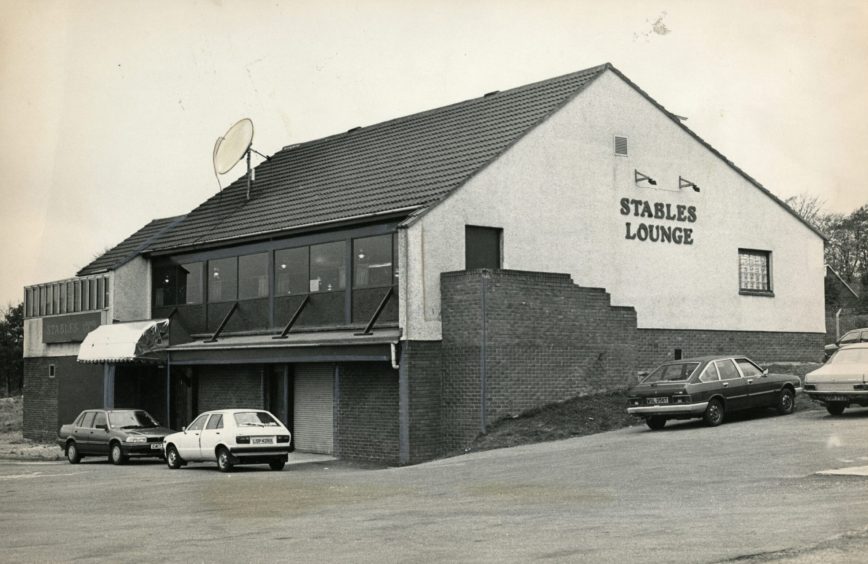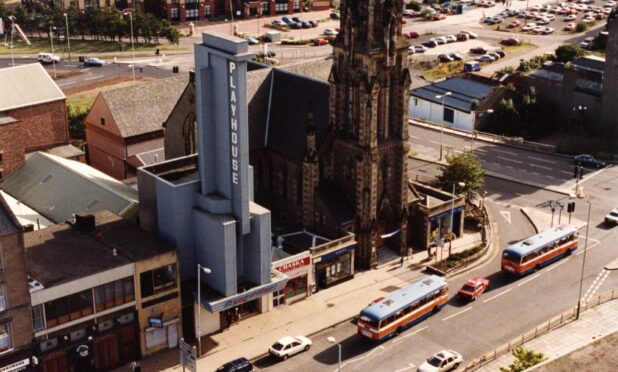
It was the Dundee satellite pub which zoned in on the stars of the 1980s.
EastEnders, Coronation Street and Page 3 stars fell into the obit of The Stables which broke new ground in entertainment in the city.
The Stables became a well-known landmark at Dryburgh Industrial Estate due to its “roof mounted satellite dish for international TV reception”.
In 1987 there were nips for 50p and Linda Lusardi pulling pints behind the bar.
These were heady days.
Dundee Pubs author Brian King recalled how the boozer was called the Oasis when first opening in 1979 at the corner of Faraday Street and Baird Avenue.
“It would appear a strange place to build a pub,” he said.
“But actually it was a good idea being that it was an oasis in the desert of the industrial estate where there was no place else to drink.
“Although it seemed isolated it was also within easy walking distance of both Ardler and Dryburgh and was popular with Timex workers from the Camperdown plant.”
The pub changed hands in 1984 and was known as the Stables in 1986.
“Space-age plans” to install a “special dish” made headlines in July 1986 when the new licensee applied to Dundee District Council for planning permission.
The satellite dish, measuring 1.8 metres in diameter, was mounted on the roof by ELN Communications of Rosyth and would receive 18 channels including Music Box.
This was something special.
Remember Sky was just the big blue thing over our heads back in 1986.
The 18 channels included Premiere which gave customers access to “up-to-date feature films” and it was possible to watch Italian football on a Sunday afternoon.
These were the days when Diego Maradona was playing for Napoli.
Plenty to drink at The Stables pub in Dundee
Tennent’s Lager, Tennent’s Export, McEwan’s 80/-, McEwan’s 70/-, Guinness and Blackthorn Cider were on draught alongside the “usual wide range of spirits”.
There was a fine selection of bottled beers including “overseas refreshments” such as Red Stripe, Beck’s, Swan Lager from Australia, Grolsch and Holsten Pils.
The new look Stables Lounge and Function Suite would be officially opened by former EastEnders actor Ross Davidson on November 8 1986.
Nips would cost 50p from 7.30pm-midnight at the “Smirnoff Vodka party night”.
Davidson played Andy O’Brien before his character was killed off in a road accident in August 1986 and he was fulfilling a series of personal appearances.
He would arrive in Dundee after opening a branch of Comet in Rutherglen.
An Evening Telegraph advertising feature ahead of the opening said the Stables offered “drinks at give-away prices” and “stars rubbing shoulders with the clientele”.
The Tele said the appearance of “dishy Ross” would be followed by a chance to meet Coronation Street “heart-throb” Chris Quinten who played Brian Tilsley.
Quinten was due to appear on November 21 at a special Bacardi promotion night which would also mark the opening of the “sophisticated new disco”.
The “celebrity month” would finish up with pin-up star Linda Lusardi appearing on November 28 which was a “Konig Pils and cider promotion evening”.
Stables was open seven days a week from 11am to 11pm Monday to Thursday and 11am until midnight on Friday, Saturday and Sunday.
Bar lunches were also a feature with “filled rolls, pies and bridies” served daily and the function suite was the place for weddings, anniversaries and birthday parties.
The suite was “decorated in a cheerful red theme” with its own disco lights and deck and the Stables would provide their “own resident jock if required”.
General manager Ian Manson said the suite could take 100 “for drinking and jigging” although 60-70 was a more realistic number “if you intend to eat as well”.
A “finger buffet” could be put on if you needed to line the stomach before 50p nips.
Corrie star was public enemy #1
Things started well enough.
But there was trouble ahead.
On November 21 Chris Quinten failed to arrive from the cobbles of Weatherfield after cancelling three personal appearances in Dundee, Glenrothes and Methil.
The actor was due to appear at the Stables Lounge, Rick’s Videoteque in Methil and a bingo hall in Glenrothes but pulled out at the eleventh hour.
He didn’t give a reason.
Around 300 people were waiting to see him at the Stables.
Mr Manson said: “I’ve just had to announce that he’s cancelled and it’s me that all the complaints and the anger has been thrown at.”
He agreed never to book the soap star again.
Things got worse when Linda Lusardi pulled out of appearing on November 28.
The visit of top model Maria Whittaker did go ahead in December 1986 with queues lined round the block and Mr Manson having to bring in extra door staff.
“It’s sheer bedlam,” he said.
“My phone has never stopped ringing.”
In February 1987 Eddie Kidd arrived at the Stables to meet his fans after working as a stunt double for Timothy Dalton in James Bond movie The Living Daylights.
He was followed by the rescheduled appearance of Linda Lusardi who drew a large crowd of male admirers and finished the evening behind the bar pouring pints.
The top stars kept coming but things were about to change.
Could the good times last?
The pub changed hands in 1987 and was put up for sale in 1988.
Things started to go downhill and the function room was closed by the licensing board because of disturbances late at night which could be heard half a mile away.
Rob Roy Inns Ltd were owners in 1989 when the 2am licence was restored and the function room opened again with the pub now called the Camperdown Arms.
There was live music on Thursday and Friday.
The troubled pub was forced to stop trading in February 1991.
Tayside chief constable Jack Bowman objected to the structure of the company that owned the pub and “its association with two Dundee businessmen”.
Mr Bowman claimed the two businessmen owned all the shares of Rob Roy Inns Ltd but he did not consider them to be “fit and proper persons to hold a licence”.
The shutters stayed down despite an appeal to the Court of Session.
In September 1991 a fire swept through the pub shortly after 3am one Saturday morning which caused thousands of pounds worth of damage to the building.
The pub was hit by a spate of break-ins and vandalism before becoming a dumping ground for illegal fly-tippers which brought more unwanted headlines in 1994.
Time was called for good.
The building was eventually demolished.
The area once again took on the appearance of an ordinary industrial estate, leaving no indication that it was once the site of one of Dundee’s most unusual pubs.
Perhaps the Oasis was just a mirage after all.
















Conversation